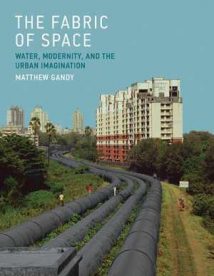نام کتاب: The Fabric Of Space – Water, Modernity, And The Urban Imagination
نویسنده: Matthew Gandy
ویرایش: ۱
سال انتشار: ۲۰۱۴
کد ISBN کتاب: ۹۷۸۰۲۶۲۰۲۸۲۵۷, ۰۲۶۲۰۲۸۲۵۵,
فرمت: PDF
تعداد صفحه: ۳۶۸
حجم کتاب: ۵۶ مگابایت
کیفیت کتاب: OCR
انتشارات: Mit Press
Description About Book The Fabric Of Space – Water, Modernity, And The Urban Imagination From Amazon
Water lies at the intersection of landscape and infrastructure, crossing between visible and invisible domains of urban space, in the tanks and buckets of the global South and the vast subterranean technological networks of the global North. In this book, Matthew Gandy considers the cultural and material significance of water through the experiences of six cities: Paris, Berlin, Lagos, Mumbai, Los Angeles, and London. Tracing the evolving relationships among modernity, nature, and the urban imagination, from different vantage points and through different periods, Gandy uses water as a lens through which to observe both the ambiguities and the limits of nature as conventionally understood. Gandy begins with the Parisian sewers of the nineteenth century, captured in the photographs of Nadar, and the reconstruction of subterranean Paris. He moves on to Weimar-era Berlin and its protection of public access to lakes for swimming, the culmination of efforts to reconnect the city with nature. He considers the threat of malaria in Lagos, where changing geopolitical circumstances led to large-scale swamp drainage in the 1940s. He shows how the dysfunctional water infrastructure of Mumbai offers a vivid expression of persistent social inequality in a postcolonial city. He explores the incongruous concrete landscapes of the Los Angeles River. Finally, Gandy uses the fictional scenario of a partially submerged London as the starting point for an investigation of the actual hydrological threats facing that city.
درباره کتاب The Fabric Of Space – Water, Modernity, And The Urban Imagination ترجمه شده از گوگل
آب در تقاطع چشم انداز و زیرساخت ها ، عبور از بین دو حوزه قابل مشاهده و نامرئی فضای شهری ، در مخازن و سطل های جنوب جهانی و شبکه های گسترده فناوری زیرزمینی شمال جهانی قرار دارد. در این کتاب ، متیو گندی اهمیت فرهنگی و مادی آب را از طریق تجربیات شش شهر پاریس ، برلین ، لاگوس ، بمبئی ، لس آنجلس و لندن در نظر گرفته است. با ردیابی روابط در حال تکامل بین مدرنیته ، طبیعت و تخیل شهری ، از نقاط مختلف و در دوره های مختلف ، گاندی از آب به عنوان عدسی استفاده می کند که از طریق آن می توان ابهامات و محدودیت های طبیعت را که به طور متعارف درک می شود مشاهده کرد. گاندی با فاضلاب های پاریسی قرن نوزدهم آغاز می شود ، که در عکس های نادار گرفته شده و بازسازی قنات پاریس. او به برلین دوران ویمار و حفاظت از دسترسی عمومی آن به دریاچه ها برای شنا می رود ، که اوج تلاش برای اتصال دوباره شهر به طبیعت است. او تهدید مالاریا را در لاگوس ، جایی که تغییر شرایط ژئوپلیتیکی منجر به تخلیه باتلاق در مقیاس بزرگ در دهه ۱۹۴۰ می شود ، می داند. او نشان می دهد که چگونه زیرساخت های آب ناکارآمد بمبئی بیان زنده ای از نابرابری اجتماعی مداوم را در یک شهر پسااستعماری ارائه می دهد. او در مناظر بتونی ناسازگار رودخانه لس آنجلس کاوش می کند. سرانجام ، گاندی از سناریوی داستانی یک لندن نیمه فرو رفته به عنوان نقطه آغاز بررسی تهدیدات واقعی هیدرولوژیکی پیش روی آن شهر استفاده می کند.
[box type=”info”]![]() جهت دسترسی به توضیحات این کتاب در Amazon اینجا کلیک کنید.
جهت دسترسی به توضیحات این کتاب در Amazon اینجا کلیک کنید.![]() در صورت خراب بودن لینک کتاب، در قسمت نظرات همین مطلب گزارش دهید.
در صورت خراب بودن لینک کتاب، در قسمت نظرات همین مطلب گزارش دهید.

